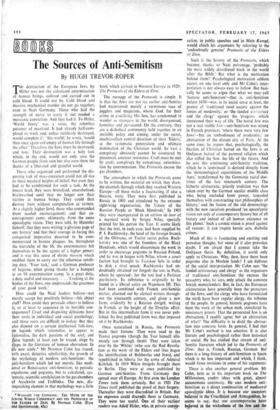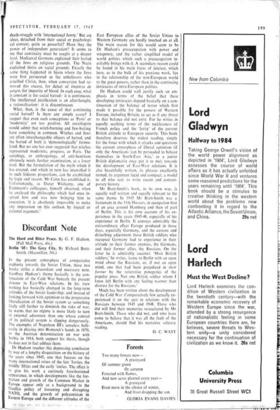The Sources of Anti-Semitism
By HUGH TREVOR-ROPER
'Via destruction of the European Jews by I. Hitler was not the calculated extermination of human beings, ordered and carried out in cold blood. It could not be. Cold blood and massive mechanical murder do not go together, even in Nazi Germany. Those who had the strength of nerve to carry it out needed a messianic conviction. And they had it. To Hitler, 'World Jewry' was a virus, the relentless poisoner of mankind. It had already half-com- pleted its work and, unless ruthlessly destroyed, would complete it : 'this world,' he wrote, 'would then once again sail empty of human life through the ether.' Therefore the Jews must be destroyed, and now. Their destruction was a holy task which, in the end, would not only save the German people from ruin but also earn them n the thanks of a liberated and grateful world.
Those who organised and performed the dis- gusting task of mass-execution could not all rise to these mystical heights of belief; but even they had to be conditioned for such a task. At the lowest level, they were brutalised, anaesthetised, brainwashed until they no longer saw their victims as human beings. They could then destroy them without compunction as vermin. At a slightly higher level, those who commanded them needed encouragement; and that en- couragement came, ultimately, from the same apocalyptic vision. They were told, by Himmler himself, that they were writing 'a glorious page of our history' and that their courage in facing this categorical imperative deserved to be com- memorated in bronze plaques. So, throughout the hierarchy of the SS, the exterminators felt themselves to be the agents of a higher power; and it was this sense of divine mission which enabled them to carry out the otherwise revolt- ing duty. 'Your task,' said a German professor of hygiene, when giving thanks for a banquet at an SS extermination camp, 'is a great duty, a duty useful and necessary. . . . Looking at the bodies of the Jews, one understands the greatness of your good work.'
How could the Nazi leaders believe—not merely accept but positively believe—this abject stuff? How could they persuade others to believe it, or at least to acquiesce in its horrible con- sequences? Cruel and disgusting delusions have their roots in individual and social psychology, and those roots are difficult to isolate. But they also depend on a certain intellectual folk-lore, On legends which rationalise, or appear to iationalise, the dark passions of the soul; and ese legends at least can be traced, stage by sge, in the literature of human aberration. In las new study,* Mr Norman Cohn has traced, With exact, detective scholarship, the growth of the mythology of modern anti-Semitism: the anti-Semitism which led not merely, like medi- eval or Renaissance anti-Semitism, to periodic expulsions and pogroms, but to calculated, sys- tematic, scientific annihilation in the gas chambers of Auschwitz and Treblinka. The new, dis- tinguishing element in that mythology was a little WARRANT FOR GENOCIDE: THE MYTH OF THE JEWISH WORLD CONSPIRACY AND ME PROTOCOLS OF MR ELDERS OF ZION. By NOI-Mall Cohn. (Eyre and Spottiswoode, 45s.) book which arrived in Western Europe in 1920: The Protocols of the Elders of Zion.
The message of the Protocols is simple. It is that the Jews are not (as earlier anti-Semites had maintained) merely a verminous race of jugglers and magicians, whom God, for their crime in crucifying His Son, has condemned to wander as strangers in the world, disorganised, homeless and persecuted. On the contrary, they are a diabolical community held together in an invisible polity and aiming, under the secret, machiavellian central direction of their 'Elders,' at the systematic penetration and ultimate domination of the Christian world. So vast a conspiracy obviously cannot be countered by piecemeal, amateur resistance. Craft must be met by craft, conspiracy by conspiracy, extermina- tion by extermination. The Protocols excuse the gas chambers.
The atmosphere in which the Protocols came to be written, the material on which they drew, the channels through which they reached Wesiern Europe—all these make a fascinating, if also a bizarre, story. They were first published in Russia in 1903 and circulated by the extreme right-wing organisation, the Union of the Russian People or 'Black Hundreds.' In 1905 they were incorporated in an edition de luxe of a mystical work by Sergey Nilus, specially printed for his patron the Tsar. It seems likely that the text, in each case, had been supplied by P. I. Rachkovsky, the head of the foreign branch of the Okhrana, or Tsarist secret police. Rach- kovsky was one of the founders of the Black Hundreds, which would disseminate the work in order to encourage pogroms in Russian Poland, and he was in league with Nilus, whom a court faction had brought to Tsarskoe Selo in order to dish a rival quack. Rachkovsky had nn- doubtedly obtained (or forged) the text in Paris, where he operated: for the text had a Parisian pre-history. Its substance is originally to be found in a liberal satire on Napoleon III. This had been combined with French anti-Semitic matter, churned out by clerical writers through- out the nineteenth century, and given a new form, evidently by a Russian émigré, writing in French, at the height of the Dreyfus affair. But in this intermediate form it was never pub- lished. Its first published form was that imposed on it by Rachkovsky.
Once naturalised in Russia, the Protocols made their fortune. They were used in the Tsarist pogroms (though the Tsar himself ulti- mately saw through them). They were taken over by the 'Whites' (who saw the Red Revolu- tion as the work of the Elders and thus began the identification of Bolsheviks and Jews), and republished in Siberia for the army of Admiral Kolchak. In 1919 White imigris brought them to Berlin. They were at once published by German anti-Semites. From Germany they spread over all Europe. At first even the London Times took them seriously. But in 1921 The Times itself published the proof of their forgery. Thereafter they were discredited in Britain. But no exposure could discredit them in Germany. They were too useful.. One of their earliest readers was Adolf Hitler, who, in private coniex- sation, in public speeches and in Mein Kampf, would clinch his arguments by referring to the 'undoubtedly genuine' Protocols of the Elders of Zion.
Such is the history of the Protocols, which became, thanks ICC Nazi patronage, –prob'ably the most widely distributed book in the world after • the Bible.' But what is the motivation behind them? Psychological motivation seldom occurs on one level only and Mr Cohn's inter- pretation is not always easy to follow. But basi- cally he seems to argue that what we may call 'historic anti-Semitism'—that is, anti-Semitism before 1870—was, in its social sense at least, the protest of 'traditional rural society against the forces of modernity.' or, `the landed arictocracy and the clergy' against the 'progress which threatened their way of life. The hated Jew was not a real visible Jew—anti-Semitism was strong in French provinces 'where there were very few Jews'—but an 'embodiment of modernity,' an abstraction of the distant city of Paris. At the same time, he argues that, psychologically, the fixation of Christian hatred on the Jews- is an Oedipean hatred of the parental religion which also stifled the Son, the life of the future. And he sees this continuing anti-Semitic tradition, which he is 'convinced' is derived directly from the `demonological superstitions of the Middle Ages,' transformed by the Germanic racial doc- trines of the late nineteenth century. The hitherto aristocratic, priestly tradition was then taken over by the German secular middle class who, being excluded from power, 'consoled themselves with constructing vast philosophies of history,' and the fusion of the old demonology with the new racialism produced 'an apocalyptic vision not only of contemporary history but of all history and indeed of all human existence on this planet.' Such a cosmic vision is proof against all reason: it can inspire heroic acts, diabolic crimes.
Much of this is fascinating and exciting and provokes thought, but some of it also provokes doubt. I am afraid that I cannot take the Oedipean thesis. By definition, it could only apply to Christians. Why, then, have there been pogroms also in Moslem lands? I am dubious of the social interpretation. Mr Cohn sees 'the landed aristrocracy and clergy' as the organisers of traditional anti-Semitism (he excuses the peasantry who, he says, only attack the concrete Jewish moneylender). But, in fact, the European aristocracies have generally been the protectors of the Jews, and the clergy who have formulated the myth have been regular clergy, the tribunes of the people. In general, historic pogroms have been the work of the urban mob, stimulated by missionary priests. That the persecuted Jew is an abstraction, I readily agree; but an abstraction of what? The difficulty is to distil the abstrac- tion into concrete form. In general, I feel that Mr Cohn's method is too selective. It is also literary and psychological rather than historical or social:He has studied that stream of anti- Semitic literature which led to the Protocols of Zion: that is, French, Russian, German. But there is a long history of anti-Semitism in Spain which is no less important and which, I think, would force revisions in some of his arguments. There is also another general problem. Mr Cohn, here as in his important book on The Millennium, credits ideas with great, almost autonomous continuity. He sees modern anti- Semitism as a direct continuation of mediaeval apocalyptic ideas. It is because our ancestors believed in the Crucifixion and Armageddon, he seems to say, that our contemporaries have believed in the wickedness of the Jew and the
death-struggle with 'international Jewry.' But are ideas, detached from their social or psychologiz cal context, quite so powerful? Have they the power of independent generation? It seems to me that continuity must be sought at a deeper level. Mediaeval Germans explained their hatred of the Jews on religious grounds. The Nazis explained theirs on racial grounds. Exactly the same thing happened in Spain where the Jews were first persecuted as the unbelievers who crucified Christ, then, when conversion had re- moved this excuse, for defect of limpieza de sangre, for impurity of blood. In each case, what is constant is the social hatred: it is continuous. The intellectual justification is an afterthought, a rationalisation: it is discontinuous.
What, then, is the cause of that continuing social hatred? Is there any simple cause? I. suspect that even such conceptions as 'Paris' or 'modernity' are too positive. All sociologists would admit that witch-burning and Jew-baiting have something in common. Witches and Jews are often interchangeable objects of hatred, and the hatred of both is `demonologically' formu- lated. But no one has ever suggested that witches represented modernity, progress, or Paris. The sociology, or anthropology, of anti-Semitism obviously needs further examination, at a lower level. But the formulation of the myth which it has created, and which in turn has intensified it to such hideous proportions, can be established by logic and reason. Mr Cohn has established it. Unfortunately, as Dieter Wisliceny, one of Eichmann's colleagues, himself observed, when he analysed the philosophy which had once in- spired him and was now bringing him to execution, 'it is absolutely impossible to make any impression on this outlook by logical or rational argument.'






























 Previous page
Previous page